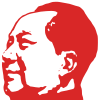Three Worlds Theory
| Part of a series on |
| Maoism |
|---|
 |
|
| Part of a series about |
| Imperialism studies |
|---|
 |
|
In the field of international relations, the Three Worlds Theory (Chinese: 三个世界的理论; pinyin: Sān gè Shìjiè de Lǐlùn) by Mao Zedong proposed to the visiting Algerian President Houari Boumédiène in February 1974 that the international system operated as three contradictory politico-economic worlds. On April 10th 1974, at the 6th Special Session United Nations General Assembly, Vice-Premier Deng Xiaoping applied the Three Worlds Theory during the New International Economic Order presentations about the problems of raw materials and development, to explain the PRC's economic co-operation with non-communist countries.[1]
The First World comprises the United States and the Soviet Union, the superpower countries respectively engaged in imperialism and in social imperialism. The Second World comprises Japan, Canada, Europe and the other countries of the global North. The Third World comprises China, the countries of Africa, Latin America, and continental Asia.[2]
As political science, the Three Worlds Theory is a Maoist interpretation and geopolitical reformulation of international relations, which is different from the Three-World Model, created by the demographer Alfred Sauvy in which the First World comprises the United States, the United Kingdom, and their allies; the Second World comprises the Soviet Union, the People's Republic of China, and their allies; and the Third World comprises the economically-underdeveloped countries, including the 120 countries of the Non-Aligned Movement (NAM).[3]
Criticism[]
In the 1970s, the Party of Labour of Albania led by Enver Hoxha began to openly criticize the Three Worlds Theory, describing it as anti-Leninist and a chauvinist theory. These criticisms were elaborated upon at length in works by Enver Hoxha, including The Theory and Practice of the Revolution and , and were made also published in the newspaper of the Party of Labour of Albania, Zëri i Popullit. The publication of these works and the now active criticism of the Three Worlds Theory in Albanian media played a hand in the growing ideological divide between Albania and China that would ultimately culminate in Albania denouncing the People's Republic of China and Maoism as revisionist.[4][5]
See also[]
- Africa–China relations
- World-systems theory
- Third-Worldism
- Third World socialism
- Maoism–Third Worldism
- First World
- Second World
- Third World
- Fourth world
- Developed country
- Developing country
- Anti-revisionism
References[]
- ^ Teng Hsiao-ping (April 12, 1974). "Excerpts From Chinese Address to U. N. Session on Raw Materials; Plundering, Bullying' High-Handed Measures' Independent Development". The New York Times. Retrieved February 21, 2015.
- ^ Gillespie, Sandra (2004). "Diplomacy on a South-South Dimension". In Slavik, Hannah (ed.). Intercultural Communication and Diplomacy. Diplo Foundation. p. 123.
- ^ Penguin Dictionary of International Relations (1998) Graham Evan and Jeffrey Newnham, eds., pp. 314–15
- ^ Hoxha, Enver (1978). "Imperialism and the Revolution". Retrieved 21 June 2021.
- ^ Hoxha, Enver (1977). "The Theory and Practice of the Revolution". Retrieved 21 June 2021.
External links[]
- On the Question of the Differentiation of the Three Worlds
- Communist Party of China – The letter in 25 points
- Renmin Ribao on the Three Worlds Theory
- Speech by Deng Xiaoping at the Special Session of the U.N. General Assembly
- Enver Hoxha: Imperialism and the Revolution – Part Two
- Communist Party of Peru on the three worlds
- Communist Party of Turkey/Marxist-Leninist on the three worlds
- Red Army Fraction: statement made on November 1972
- Ideology of the Chinese Communist Party
- Maoism
- Country classifications
- Imperialism studies
- Political philosophy stubs
- Chinese philosophy stubs
